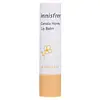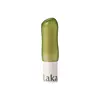What's inside
What's inside
 Key Ingredients
Key Ingredients

 Benefits
Benefits

 Concerns
Concerns

 Ingredients Side-by-side
Ingredients Side-by-side

Petrolatum
EmollientPolyglyceryl-2 Triisostearate
EmulsifyingDiisostearyl Malate
EmollientParaffinum Liquidum
EmollientJojoba Esters
EmollientHydrogenated Polyisobutene
EmollientPolyethylene
AbrasiveMeadowfoam Delta-Lactone
Skin ConditioningPhytosteryl Hydroxystearate
Skin ConditioningHydrogenated Coco-Glycerides
EmollientEuphorbia Cerifera Wax
Microcrystalline Wax
Emulsion StabilisingMangifera Indica Seed Butter
Skin ConditioningCeresin
Emulsion StabilisingPrunus Amygdalus Dulcis Oil
Skin ConditioningTrihydroxystearin
Skin ConditioningPhenoxyethanol
PreservativeCaprylyl Glycol
EmollientParfum
MaskingGlyceryl Caprylate
EmollientTocopheryl Acetate
AntioxidantCI 19140
Cosmetic ColorantCI 15985
Cosmetic ColorantTocopherol
AntioxidantTbhq
AntioxidantWater
Skin ConditioningBrassica Campestris Seed Oil
Skin ConditioningGlycerin
HumectantButylene Glycol
HumectantCamellia Sinensis Leaf Extract
AntimicrobialCamellia Japonica Leaf Extract
Skin ConditioningOrchid Extract
Skin ConditioningOpuntia Coccinellifera Fruit Extract
Skin ConditioningCitrus Unshiu Peel Extract
MaskingHoney Extract
HumectantEthylhexylglycerin
Skin ConditioningPetrolatum, Polyglyceryl-2 Triisostearate, Diisostearyl Malate, Paraffinum Liquidum, Jojoba Esters, Hydrogenated Polyisobutene, Polyethylene, Meadowfoam Delta-Lactone, Phytosteryl Hydroxystearate, Hydrogenated Coco-Glycerides, Euphorbia Cerifera Wax, Microcrystalline Wax, Mangifera Indica Seed Butter, Ceresin, Prunus Amygdalus Dulcis Oil, Trihydroxystearin, Phenoxyethanol, Caprylyl Glycol, Parfum, Glyceryl Caprylate, Tocopheryl Acetate, CI 19140, CI 15985, Tocopherol, Tbhq, Water, Brassica Campestris Seed Oil, Glycerin, Butylene Glycol, Camellia Sinensis Leaf Extract, Camellia Japonica Leaf Extract, Orchid Extract, Opuntia Coccinellifera Fruit Extract, Citrus Unshiu Peel Extract, Honey Extract, Ethylhexylglycerin
Helianthus Annuus Seed Oil
EmollientOctyldodecanol
EmollientPolyglyceryl-2 Triisostearate
EmulsifyingCetyl Ethylhexanoate
EmollientButyrospermum Parkii Butter
Skin ConditioningPhytosteryl/Isostearyl/Cetyl/Stearyl/Behenyl Dimer Dilinoleate
Skin ConditioningSynthetic Wax
AbrasivePolyglyceryl-2 Isostearate/Dimer Dilinoleate Copolymer
EmollientMicrocrystalline Wax
Emulsion StabilisingDiisostearyl Malate
EmollientRicinus Communis Seed Oil
MaskingCeresin
Emulsion StabilisingEuphorbia Cerifera Wax
Macadamia Seed Oil Polyglyceryl-6 Esters Behenate
EmollientSorbitan Olivate
EmulsifyingPrunus Amygdalus Dulcis Oil
Skin ConditioningSorbitan Sesquioleate
EmulsifyingTocopheryl Acetate
AntioxidantPolyglyceryl-6 Polyricinoleate
EmulsifyingCitrus Aurantium Dulcis Oil
MaskingDehydroacetic Acid
PreservativeCitrus Nobilis Peel Oil
MaskingLitsea Cubeba Fruit Oil
MaskingWater
Skin ConditioningLimnanthes Alba Seed Oil
Skin ConditioningTocopherol
AntioxidantHydrolyzed Hyaluronic Acid
HumectantButylene Glycol
Humectant1,2-Hexanediol
Skin ConditioningGlycerin
HumectantPersea Gratissima Fruit Extract
EmollientBrassica Oleracea Acephala Leaf Extract
HumectantHelianthus Annuus Seed Oil, Octyldodecanol, Polyglyceryl-2 Triisostearate, Cetyl Ethylhexanoate, Butyrospermum Parkii Butter, Phytosteryl/Isostearyl/Cetyl/Stearyl/Behenyl Dimer Dilinoleate, Synthetic Wax, Polyglyceryl-2 Isostearate/Dimer Dilinoleate Copolymer, Microcrystalline Wax, Diisostearyl Malate, Ricinus Communis Seed Oil, Ceresin, Euphorbia Cerifera Wax, Macadamia Seed Oil Polyglyceryl-6 Esters Behenate, Sorbitan Olivate, Prunus Amygdalus Dulcis Oil, Sorbitan Sesquioleate, Tocopheryl Acetate, Polyglyceryl-6 Polyricinoleate, Citrus Aurantium Dulcis Oil, Dehydroacetic Acid, Citrus Nobilis Peel Oil, Litsea Cubeba Fruit Oil, Water, Limnanthes Alba Seed Oil, Tocopherol, Hydrolyzed Hyaluronic Acid, Butylene Glycol, 1,2-Hexanediol, Glycerin, Persea Gratissima Fruit Extract, Brassica Oleracea Acephala Leaf Extract
Ingredients Explained
These ingredients are found in both products.
Ingredients higher up in an ingredient list are typically present in a larger amount.
Butylene Glycol (or BG) is used within cosmetic products for a few different reasons:
Overall, Butylene Glycol is a safe and well-rounded ingredient that works well with other ingredients.
Though this ingredient works well with most skin types, some people with sensitive skin may experience a reaction such as allergic rashes, closed comedones, or itchiness.
Learn more about Butylene GlycolCeresin is a wax derived from ozokerite. It is an alternative to beeswax.
The most common process of creating ceresin is by using heat and sulfuric acid.
Diisostearyl Malate is an emollient and most often used in lip products. It comes from isostearyl alcohol, a fatty acid, and malic acid, an AHA.
As an emollient, Diisostearyl Malate helps create a thin film on your skin to trap moisture in. This helps keep your skin soft and smooth.
Glycerin is already naturally found in your skin. It helps moisturize and protect your skin.
A study from 2016 found glycerin to be more effective as a humectant than AHAs and hyaluronic acid.
As a humectant, it helps the skin stay hydrated by pulling moisture to your skin. The low molecular weight of glycerin allows it to pull moisture into the deeper layers of your skin.
Hydrated skin improves your skin barrier; Your skin barrier helps protect against irritants and bacteria.
Glycerin has also been found to have antimicrobial and antiviral properties. Due to these properties, glycerin is often used in wound and burn treatments.
In cosmetics, glycerin is usually derived from plants such as soybean or palm. However, it can also be sourced from animals, such as tallow or animal fat.
This ingredient is organic, colorless, odorless, and non-toxic.
Glycerin is the name for this ingredient in American English. British English uses Glycerol/Glycerine.
Learn more about GlycerinMicrocrystalline Wax is created by de-oiling petroleum. It is highly refined and purified before being added to cosmetics.
Microcrystalline Wax is used to enhance the texture and create even consistency. It helps stabilize a product by preventing ingredients from separating.
This ingredient is a form of glycerin with emulsifying and emollient properties.
As an emulsifier, this ingredient helps keep products together while adding a thick texture. The manufacturer states this ingredient has emollient properties. Emollients help keep the skin hydrated by trapping moisture in.
Polyglyceryl-2 Triisostearate is created by reacting diglycerin and isostearic acid. Due to the isostearic acid base, it may not be safe for Malassezia or fungal acne.
Learn more about Polyglyceryl-2 TriisostearatePrunus Amygdalus Dulcis Oil comes from the sweet almond, a tree native to Iran. This oil has no fragrance and is non-volatile.
Almonds contain healthy fats, vitamins, and minerals. It is a rich source of Vitamin E, a great antioxidant and skin conditioning ingredient. Sweet almond oil contains fatty acids such as linolenic acid and triglycerides.
The content of sweet almond oil makes it a great emollient; it can help soften and hydrate your skin. Emollients create a barrier over your skin to trap moisture in. Sweet almond oil has antioxidant properties.
Those with an almond allergy should be careful of this ingredient and speak with a professional about using it in your skincare.
This ingredient may not be fungal-acne safe.
Learn more about Prunus Amygdalus Dulcis OilTocopherol (also known as Vitamin E) is a common antioxidant used to help protect the skin from free-radicals and strengthen the skin barrier. It's also fat soluble - this means our skin is great at absorbing it.
Vitamin E also helps keep your natural skin lipids healthy. Your lipid skin barrier naturally consists of lipids, ceramides, and fatty acids. Vitamin E offers extra protection for your skin’s lipid barrier, keeping your skin healthy and nourished.
Another benefit is a bit of UV protection. Vitamin E helps reduce the damage caused by UVB rays. (It should not replace your sunscreen). Combining it with Vitamin C can decrease sunburned cells and hyperpigmentation after UV exposure.
You might have noticed Vitamin E + C often paired together. This is because it is great at stabilizing Vitamin C. Using the two together helps increase the effectiveness of both ingredients.
There are often claims that Vitamin E can reduce/prevent scarring, but these claims haven't been confirmed by scientific research.
Learn more about TocopherolTocopheryl Acetate is AKA Vitamin E. It is an antioxidant and protects your skin from free radicals. Free radicals damage the skin by breaking down collagen.
One study found using Tocopheryl Acetate with Vitamin C decreased the number of sunburned cells.
Tocopheryl Acetate is commonly found in both skincare and dietary supplements.
Learn more about Tocopheryl AcetateWater. It's the most common cosmetic ingredient of all. You'll usually see it at the top of ingredient lists, meaning that it makes up the largest part of the product.
So why is it so popular? Water most often acts as a solvent - this means that it helps dissolve other ingredients into the formulation.
You'll also recognize water as that liquid we all need to stay alive. If you see this, drink a glass of water. Stay hydrated!
Learn more about WaterEuphorbia Cerifera wax comes from a shrub in Northern Mexico. It is used to stabilize formulations and has emollient properties.
Emollients form a thin layer on top of skin to prevent water from evaporating, keeping skin and lips hydrated.
According to a manufacturer, this wax can range from a yellow/brown color to translucent.
Learn more about Euphorbia Cerifera Wax